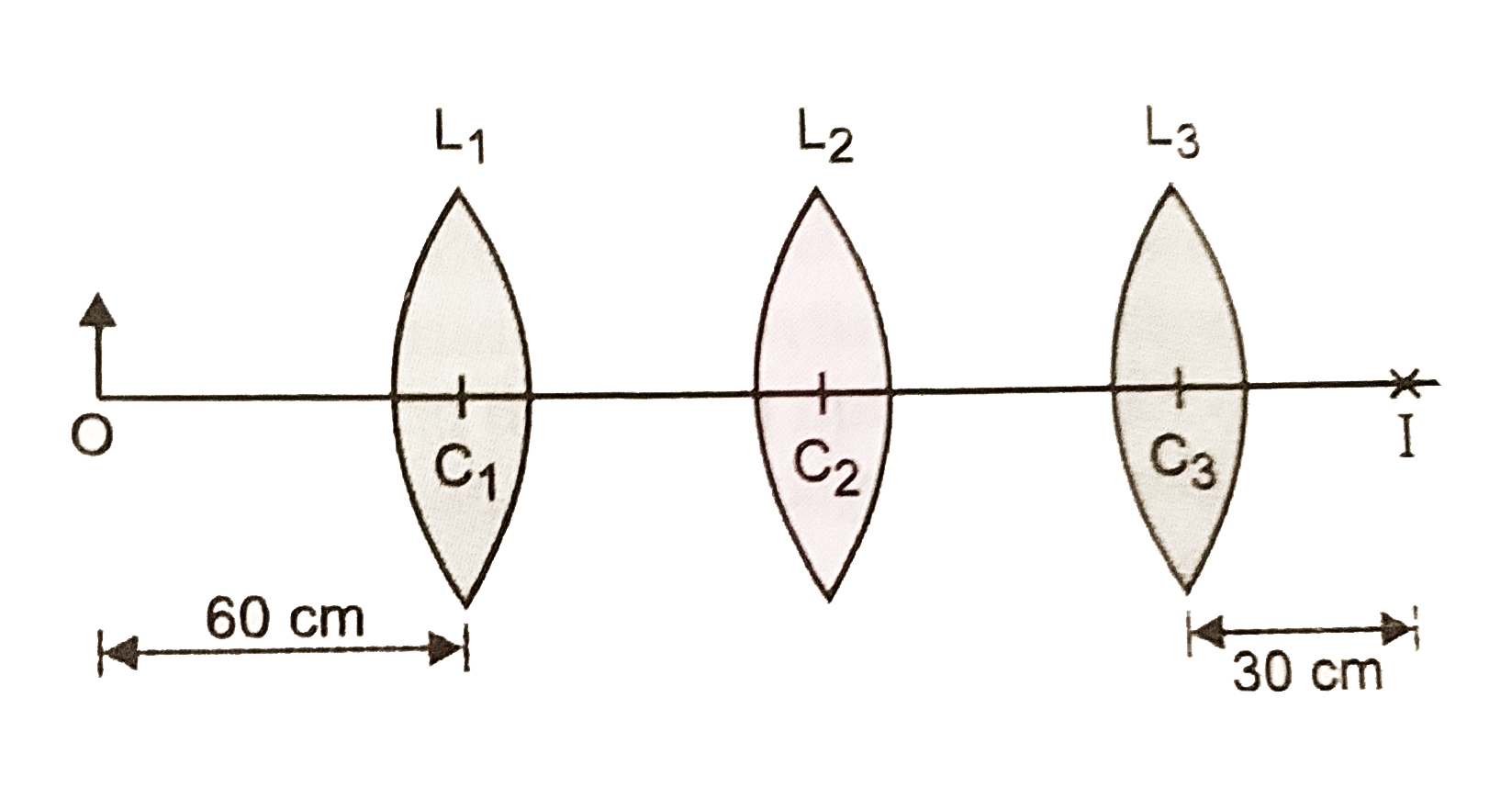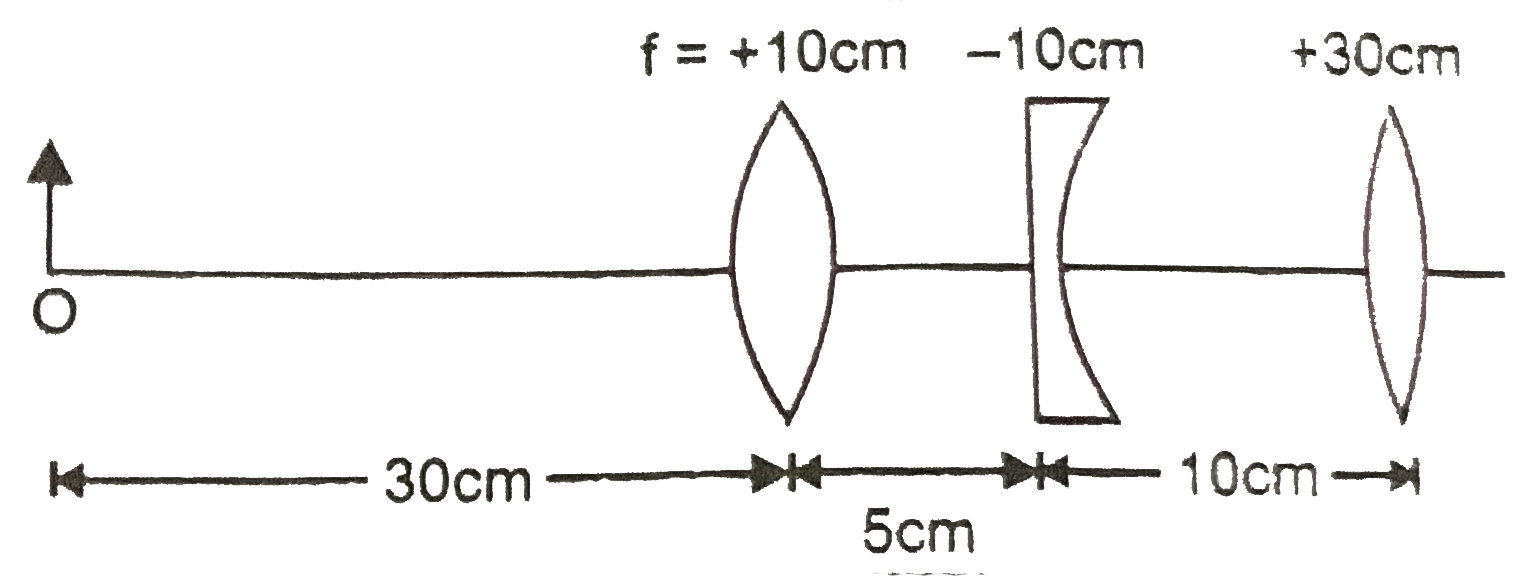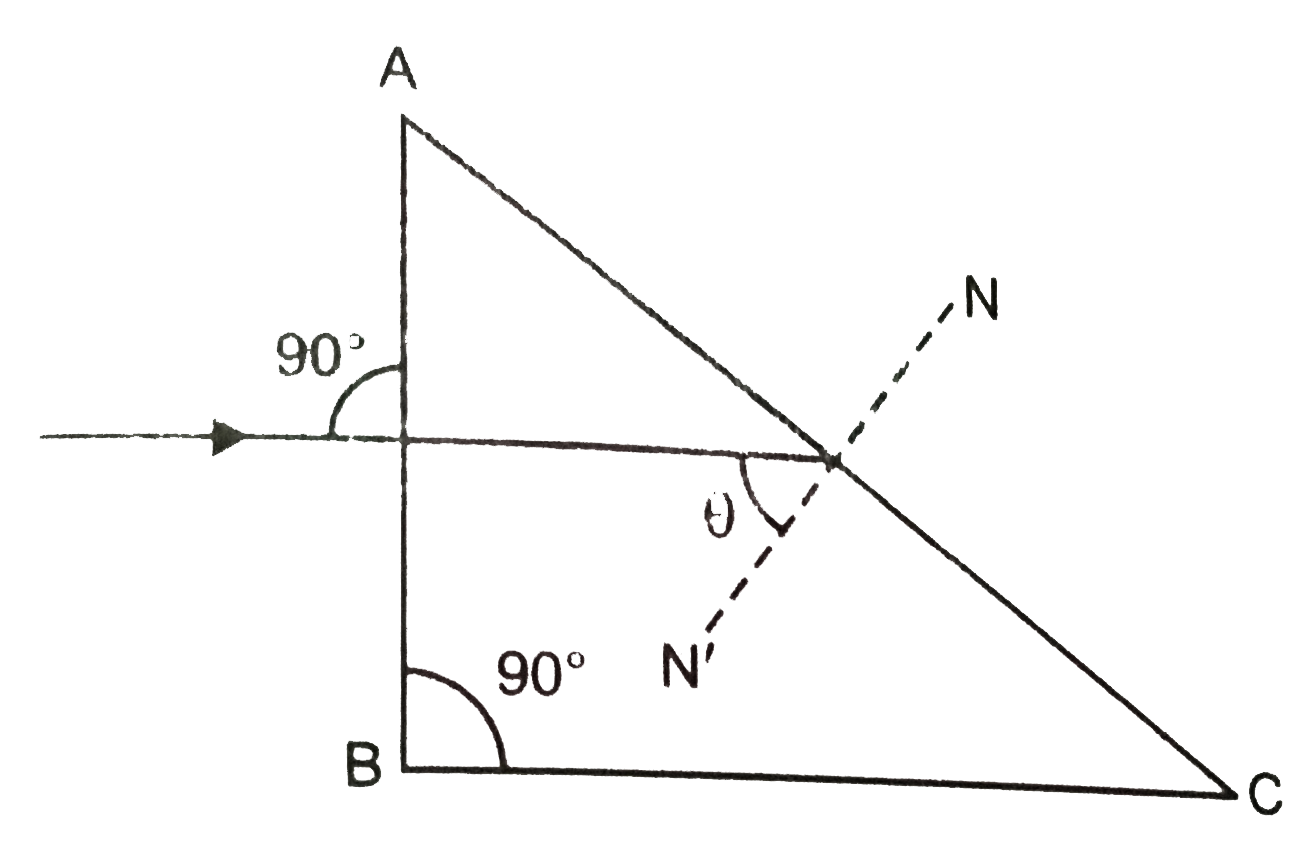Complete Solutions to Solved Example(b) of chapter RAY OPTICS of Class 11 book with complete answers and questions
| Class 11 | PHYSICS |
| Chapter | RAY OPTICS |
| PRADEEP | Solved Example(b) |
| Number Of Questions | 61 |
| Academic Year | 2023-24 |
A light of wavelength `6000 A` in air, enters a medium with refractive index 1.5 Inside the medium its frequency is….Hz and its wavelength is ….`A`
View SolutionWhat is the speed of light in glass of refractive index `1.5` ? Given speed of light in water is `2.25 xx 10^8 m//s` and refractive index of water is `1.3`.
View SolutionA rectangular glass slab rests at the bottom of a trough of water. A ray of light incident on water surface at an angle of `50^(@)` passes through water into glass. What is angle of refraction in glass ? Take `mu` for water `4//3` and `mu` for glass `3//2`.
View SolutionWhat is the apparent position of an object below a rectangular block of glass `6 cm` thick, if a layer of water `4 cm` thick is on the top of the glass ? Given `^(a)mu_(g) = 3//2 and ^(a)mu_(w) = 4//3`.
View SolutionA ray of light is incident at an angle of `45^@` on one face of a rectangular glass slab of thickness `10 cm` and refractive index `1.5`. Calculate the lateral shift produced.
View SolutionRefractive indices of water an glass are `4//3 and 3//2` respectively. A ray of light travelling in water is incident on the water glass interface at `30^@`. Calculate the angle of refraction.
View SolutionA ray `PQ` is incident normally on the refracting face of the prism `BAC` made of material of refractive index `1.5`. Complete the path of ray through the prism. From which face will the ray emerge and at what angle ? Justify your answer.
View SolutionA transparent cube of side `210 mm` contains a small air bubble. Its apparent distance, when viewed from one face of the cube is `100 mm`, and when viewed through opposite face is `40 mm`. What is the actual distance of the bubble from the second face and what is the refractive index of the material of the cube ?
View SolutionRefractive indices of water an glass are `4//3 and 3//2` respectively. A ray of light travelling in water is incident on the water glass interface at `30^@`. Calculate the angle of refraction.
View SolutionCalculate the speed of light in a medium whose critical angle is `30^@`.
View SolutionThe critical angle of incidence in a glass slab placed in air is `45^@`. What will be be the critical angle when the glass slab is immersed in water of refractive index `1.33` ?
View SolutionDetermine the direction in which a fish under water sees the setting sun. Given, for water `mu = 1.33`.
View SolutionThe refractive index of water is `4//3`. Determine the angle of the cone within which the entire outside view will be confined for a fish under water.
View SolutionA point source of light `S` is placed at the bottom of a vessel containing a liquid of refractive index `5//3`. A person is viewing the source from above the surface. There is an opaque disc of radius `1 cm` floating on the surface. The centre of disc lies vertically above the source `O`. The liquid from the vessel is gradually drained out through a tap. What is the maximum height of the liquid for which the source cannot be seen at all.
View SolutionDetermine the critical angle for a glass interface, if a ray of light, which is incident in air on the surface is deviated through `15^@`, when its angle of incidence is `40^@`.
View SolutionCalculate the critical angle foe total internal reflection of light travelling from
(i) water into air
(ii) glass into water. Given, `.^(a)mu_(w) = 1.33` and `.^(a)mu_(g) = 1.5`.
View SolutionOne face of a prism of refractive index `1.5` and angle `75^@` is covered with a liquid of refractive index `(3 sqrt(2))/(4)`. What should be the angle of incidence of light on the clear face of prism for which light is just totally reflected at the liquid covered face ?
View SolutionCalculate the critical angle for a glass air interface, if a ray of light incident in air on the surface is deviated through `15^@`, when its angle of incidence is `40^@`.
View SolutionA glass dumbbell of length `30 cm` and refractive index `1.5` has ends of radius of curvature `3cm`. A point object is situated at a distance of `12 cm` from one end of dumbbell. Find the position of the image formed due to refraction ai one end only.
View SolutionA mark placed on the surface of a sphere is viewed through glass from a position directly opposite. If the diameter of the sphere is `10 cm` and refractive index of glass is `1.5`, find the position of the image.
View SolutionLight from a point source in air falls on a convex spherical glass surface `(mu = 1.5 and R = 20 cm)`. Calculate position of the image when the light source is at `1m` from the glass surface.
View SolutionAn empty spherical flask of diameter `15 cm` is placed in water of `mu = 4//3`. A parallel beam of light strikes the flask. Where does it get focussed, when observed from within the flask ?
View SolutionLight from a point source in air falls on a convex spherical glass surface `(mu = 1.5 and R = 20 cm)`. Calculate position of the image when the light source is at `1m` from the glass surface.
View SolutionWhat curvature must be given to the bounding surface of `mu = 1.5` for virtual image of an object in the medium of `mu = 1 at 10 cm` to be formed at a distance of `40 cm`. Calculate power of the refracting surface and also two principal focal lengths of the surface.
View SolutionA sunshine recorder globe of `30 cm` diameter is made of glass of `mu = 1.5`. A ray enters the globe parallel to its axis. Find the position from the centre of the sphere, where the ray crosses the axis.
View SolutionA biconvex lens has focal length `(2)/(3)` times the radius of curvature of either surface. Calculate refraction index f material of the lens.
View SolutionShows a thin lens with centres of curvature `C_1 and C_2`. If `mu = 1.5`, what is its focal length ?
 .
.
View SolutionA diverging lens of refractive index `1.5` and focal length `15 cm` in air has same radii of curvature for both sides. If it is immersed in a liquid of refractive index `1.7`, calculate focal length of the lens in liquid.
View SolutionA double convex lens made of glass of refractive index `1.56` has both radii of curvature of magnitude `20 cm`. If an object is placed at a distance of `10 cm` from this lens, find the position of image formed.
View SolutionFind the radius of curvature of convex surface of a plano convex lens, whose focal length is `0.3 m and mu = 1.5`.
View SolutionA magician during a show makes a glass lens `mu = 1.5` disappear in a through of liquid. What is the refractive index of the liquid ? Is the liquid water ?
View SolutionThe focal length of an equiconvex lens is equal to radius of curvature of either surface. What is the refractive index of the material of the prism ?
View SolutionExplain what happens when a convex lens of refractive index `1.2` is immersed in a liquid of refractive index `1.3`.
View SolutionThe graph in shows the variation of image distance (v) with object distance (u) in case of a lens. Find focal length of the lens. What is the nature of the lens, if image formed is real ?
 .
.
View SolutionAt what distance should an object be placed from a convex lens of focal langth `15 cm` to obtain an image three times the size of the object ?
View SolutionThe image obtained with a convex lens is erect and its length is `4` times the length of the object. If the focal length of lens is `20 cm`, calculate the object and image distances.
View SolutionAn illuminated object and a screen are placed `90 cm` apart. What is the focal length and nature of the lens required to produce a clear image on the screen twice the size of the object ?
View SolutionA convergent beam of light passes through a diverging lens of focal length `0.2 m` and comes to focus at a distance of `0.3 m` behind the lens. Find the position of the point at which the beam would converge in the absence of the lens.
View SolutionThe image obtained with a convex lens is erect and its length is `4` times the length of the object. If the focal length of lens is `20 cm`, calculate the object and image distances.
View SolutionA converging lens of focal length `50 cm` is placed co-axially in contact with another lens of unknown focal length. If the combination behaves like a diverging lens of focal length `50 cm`, find the power and nature of second lens.
View SolutionTwo lens of power `+ 15 D and - 5 D` are in contact with each other. What is the focal length of the combination ? What would be the position of image formed by the combination for an object at `30 cm` ?
View SolutionUse the following ray diagram, Fig. to calculate focal length of lens `L_2`.
 .
.
View SolutionA convex lens of focal length `10 cm` is placed co-axially `5 cm` away from a concave lens of focal length `10 cm`. If an object is placed `30 cm` in front of the convex lens, find the position of final image formed by the combined system.
View SolutionA concave lens is placed in contact with a convex lens of focal length `25 cm`. The combination produces a real image at a distance of `80 cm`, when an object is at a distance of `40 cm`. What is the focal length of concave lens ?
View Solution(i) If `f = + 0.5 m`, what is the power of the lens ?
(ii) The radii of curvature of the faces of a double convex lens are `9 cm and 15 cm`. Its focal length is `12 cm`. What is the refractive index of glass ?
(iii) A convex lens has `20 cm` focal length in air. What is the focal length in water ? (Refractive index of air-water `= 1.33`, refractive index of air-glass `= 1.5`).
View SolutionA real image of an object is formed at a distance of `20 cm` from a lens. On putting another lens in contact with it, the image is shifted `10 cm` towards the combination, Determine the power of the second lens.
View SolutionA convex lens of focal length `30 cm` and a concave lens of focal length `60 cm` are placed in combination. If an object is placed `40 cm` away from the combination, find the position of the image.
View SolutionA double convex lens of `+ 5 D` is made of glass of refractive index `1.5` with both faces of equal radii of curvature. Find the value of curvature.
View SolutionA convex lens of focal length `25 cm` is placed co-axially in contact with a concave lens of focal length `20 cm`. Determine the power of the combination. Will the system be converging or diverging in nature ?
View SolutionThree lenses `L_1,L_2,L_3` each of focal length `30 cm` are placed co-axially as shown in (Fig. 11(b).57).
An object is held at `60 cm` from the optic centre of lens `L_1`. The final real image is formed at the focus of `L_3`. Calculate separation between
(i) `L_1` and `L_3`
(ii) `L_2` and `L_3` ?
 .
.
View SolutionA convex lens is placed in contact with a plane mirror. An axial point object at a distance of `20 cm` from this combination, has its image coinciding with itself. What is the focal length of the convex lens ?
View SolutionA convex lens and a convex mirror of radius of curvature `20 cm` are placed co-axially with the convex mirror placed at a distance of `30 cm` from the lens. For a point object at a distance of `25 cm` from the lens, the final image due to this combination coincides with the object itself. What is the focal length of convex lens ?
View SolutionA convex lens of focal length `20 cm` is placed co-axially with a convex mirrir of radius of curvature `20 cm`. The two are kept `15 cm` apart from eachother. A point object is placed `60 cm` in front of the convex lens. Find the position of the image formed by the combination.
View SolutionA convex lens of focal length `20 cm` and a convex mirror of focal length `10 cm` are placed co-axially `50 cm` apart from each other. An incident beam parallel to its principal axis is incideent on the convex lens. Locate the position of final image formed due to the combination.
View SolutionAn object is placed `15 cm` in front of a convex lens of focal length `10 cm`. Find the nature and position of image formed. Where should a concave mirror of radius of curvature `20 cm` be placed so that the final image is formed on the position of the object itself ?
View SolutionA thin convergent glass lens `(mu_g=1.5)` has a power of `+5.0D.` When this lens is immersed in a liquid of refractive index `mu_1,` it acts as a divergent lens of focal length `100 cm.` The value of `mu_1` is
View SolutionFind the position of the image formed by the lens combination given in Fig.
 .
.
View SolutionOne face of a glass cube of side `0.06 m` from the face opposite to the silvered face. Looking from the object side, the image of the object appears to be `0.11 m` behind the silvered face. Calculate the refractive index of material of glass.
View SolutionRadius of curvature of an equiconvex lans is `0.2 m`. Its refractive index is `1.5` . Calculate its focal length. If two such lenses are kept separated with common principal axis by a distance of `0.2 m`, what will be the effective focal length of the combination ?
View SolutionUsing the following data, calculate refractive index of the material of convex lens. Radii of curvature of both the surfacea are `0.2 m`.Data recorded in the displacement//shift method to determine focal length of convex lens is shown here.
View SolutionA beam of light of wavelength `400 nm` is incident normally on a right angled prism as shown in Fig.
It is observed that light just grazes along the surface `AC` after falling on it. If refractive index `mu` of the material of prism varies with wavelength
`lamda` as `mu = 1.2 + (b)/(lamda^2)`
Calculate the value of `b and mu` of prism material for `lamda = 500 nm`. Given `theta = sin^-1 (0.625)`.
 .
.
View Solution
Solved Example(b) questions and complete solutions for chapter RAY OPTICS of PRADEEP PHYSICS (HINGLISH) of Class 11
All Exercises from PRADEEP Class 11 PHYSICS RAY OPTICS
- (Competition)Comprehension
- (Competition)Multiple choice
- (Exemplar) Multiple choice
- (NCERT)Exercise With Solution
- (NCERT)Long Answer
- (NCERT)Short Answer
- (NCERT)Very Short Answer
- (Test Your Grip)Fill in the blanks (b)
- (Test Your Grip)Fill in the blanks (c)
- (Test Your Grip)Fill in the blanks (d)
- (Test Your Grip)Fill in the blanks(a)
- (Test Your Grip)Multiple Choice (b)
- (Test Your Grip)Multiple Choice (c)
- (Test Your Grip)Multiple Choice (d)
- (Test Your Grip)Multiple Choice(a)
- (Test Your Grip)Multiple Choice(sec -A)
- Assertion-Reason Question
- Conceptual Problem(a)
- Conceptual problem(b)
- Conceptual problem(c)
- Conceptual problem(d)
- Higher Thinking Order
- Integer Question
- Long Answer (a)
- Long Answer (b)
- Long Answer (c)
- Long Answer (d)
- Problem For Practice(a)
- Problem For Practice(b)
- Problem For Practice(c)
- Problem For Practice(d)
- Sample Problem(a)
- Sample problem(b)
- Sample problem(c)
- Sample problem(d)
- Short Answer(a)
- Short Answer(b)
- Short Answer(c)
- Short Answer(d)
- Solved Example(a)
- Solved Example(b)
- Solved Example(c )
- Solved Example(d)
- Very Short (a)
- Very Short Answer (b)
- Very Short Answer (c)
- Very Short Answer (d)